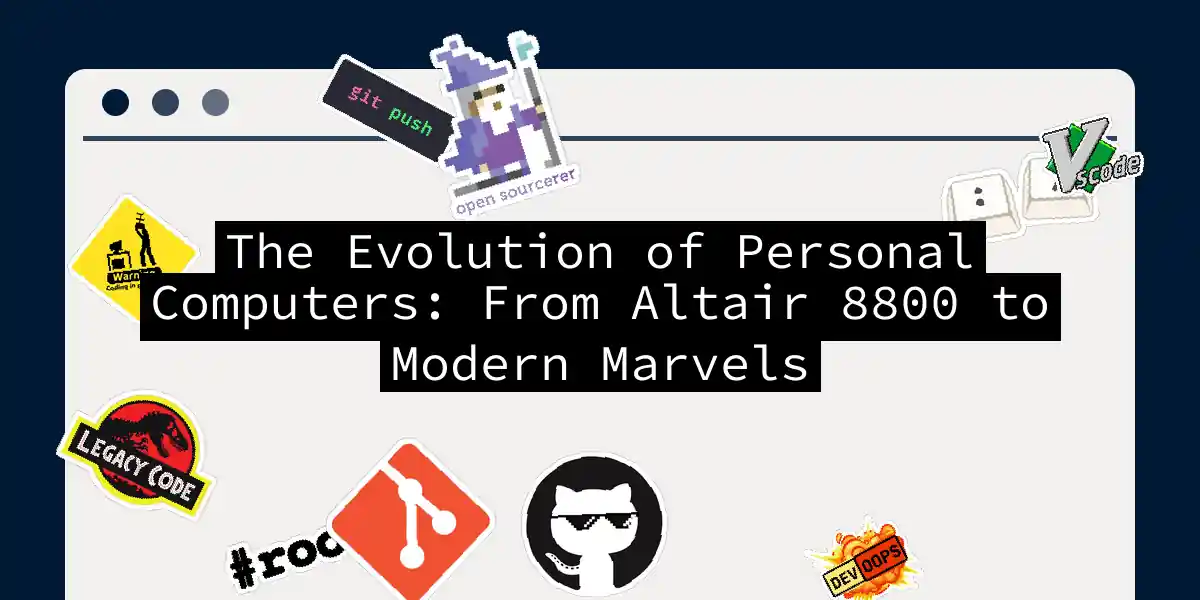The journey of personal computers is a tale of innovation, perseverance, and a dash of genius. It all began with a humble machine that sparked a revolution – the Altair 8800. In this article, we’ll delve into the fascinating history of personal computers, from the pioneering Altair 8800 to the sleek, powerful devices we use today.
The Birth of a Revolution: Altair 8800
In December 1974, the Altair 8800 was introduced to the world through the pages of Popular Electronics. This microcomputer, designed by Ed Roberts and his company MITS (Micro Instrumentation and Telemetry Systems), was based on the Intel 8080 microprocessor. The Altair 8800 was not just another electronic gadget; it was the precursor to all personal computers that followed.
Imagine a computer without a keyboard or display – that was the Altair 8800. Users input programs and data using a set of switches on the front panel, and the results were displayed in binary code via a series of LEDs. Despite its primitive interface, the Altair 8800 was a game-changer. It came with a mere 256 bytes of memory, but its potential was vast. The use of the Intel 8080 processor, which offered a significant boost in performance compared to its predecessor, the Intel 8008, was a key factor in its success.
The Open Architecture and S-100 Bus
One of the most innovative aspects of the Altair 8800 was its open architecture. Ed Roberts designed the Altair-100 bus, later known as the S-100 bus, which allowed users to expand the system by adding various peripheral devices and memory. This bus consisted of 100 lines and could support up to 16 expansion cards. The S-100 bus became a de facto standard in the industry, adopted by many other manufacturers.
The Rise of Software and Community
The Altair 8800’s impact was not limited to hardware. It also spurred the development of software. One notable example is Altair BASIC, an interpreter for the BASIC programming language developed by Bill Gates and Paul Allen. This software was inspired by the Altair 8800’s appearance on the cover of Popular Electronics and marked the beginning of Microsoft’s journey.
The Altair 8800 also fostered a community of enthusiasts who created their own expansion cards, software, and even started their own companies. This community-driven approach was a hallmark of the early personal computer era, where innovation was often driven by passion and curiosity rather than profit.
The Next Generation: Apple II and Commodore 64
As the personal computer market grew, new players entered the scene. The Apple II, introduced in 1977, was one of the first highly successful mass-produced personal computers. It came with a built-in keyboard, color graphics, and an open architecture that allowed for expansion. The Apple II was designed to be user-friendly and aesthetically pleasing, making it a favorite among both hobbyists and professionals.
The Commodore 64, released in 1982, was another iconic machine that dominated the home computer market. With its 64 KB of RAM and built-in BASIC interpreter, it became a staple for gamers and programmers alike. The Commodore 64’s affordability and versatility made it one of the best-selling single computer models of all time.
The Era of IBM and the PC Clone Market
The introduction of the IBM PC in 1981 marked a significant shift in the industry. IBM’s decision to use an open architecture and off-the-shelf components led to the creation of the PC clone market. Companies like Compaq and Dell began producing compatible machines, driving down prices and increasing accessibility.
This period also saw the rise of the x86 architecture, which would become the backbone of modern personal computers. The IBM PC’s use of the Intel 8088 processor set the stage for future generations of x86 processors, which continue to power most personal computers today.
Modern Personal Computers: A Leap Forward
Fast-forward to the present, and we find ourselves in a world where personal computers are not just powerful but also incredibly diverse. From sleek laptops to powerful gaming desktops, the options are endless.
Modern personal computers boast processors with multiple cores, gigabytes of RAM, and storage capacities that were unimaginable in the days of the Altair 8800. The advent of solid-state drives (SSDs) has significantly improved performance, while advancements in cooling systems have made high-performance computing more accessible.
Conclusion
The evolution of personal computers is a story of continuous innovation and community-driven progress. From the humble beginnings of the Altair 8800 to the sophisticated machines of today, each step has been marked by significant advancements in technology and user experience.
As software developers, we owe a debt of gratitude to pioneers like Ed Roberts, Bill Gates, and Steve Jobs, who paved the way for the powerful tools we use today. The journey of personal computers is a testament to human ingenuity and the relentless pursuit of innovation.
So the next time you boot up your laptop or desktop, remember the Altair 8800 and the revolution it sparked. It’s a reminder that even the most complex technologies have humble beginnings and that innovation can come from the most unexpected places.
